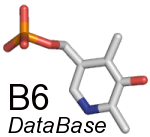|
|
| |
4.3.1.27 |
| Description |
Threo-3-hydroxy-D-aspartate ammonia-lyase |
| Alternative names |
D-threo-3-hydroxyaspartate dehydratase;
threo-3-hydroxy-D-aspartate ammonia-lyase (oxaloacetate-forming)
|
| Catalyzed reaction |
threo-3-hydroxy-D-aspartate = oxaloacetate + NH3 |
| Cofactor |
Pyridoxal-phosphate and Mn(II). |
| Comments |
A pyridoxal-phosphate protein. The enzyme, purified from the bacterium Delftia sp. HT23, also has activity against L-threo-3-hydroxyaspartate, L-erythro-3-hydroxyaspartate, and D-serine.
Different from EC 4.3.1.20, erythro-3-hydroxy-L-aspartate ammonia-lyase and EC4.3.1.16, threo-3-hydroxy-L-aspartate ammonia-lyase. Requires a divalent cation such as Mn2+, Co2+ or Ni2+. |
| |
D-threo-3-Hydroxyaspartate dehydratase (D-THA DH) isolated from the soil bacterium Delftia sp. The amino-acid sequence of D-THA DH shows significant similarity to that of two eukaryotic D-serine dehydratases derived from Saccharomyces cerevisiae and chicken kidney. D-THA DH is classified into the fold-type III group of pyridoxal enzymes and is the first example of a fold-type III dehydratase derived from a prokaryote. |
| PDB |
4PB5; |
| Organisms |
-Eubacteria |
| | |
|---|
Family |
|
| | |
|---|
| Links |
Enzyme (activities) 4.3.1.27
BRENDA (activities) 4.3.1.27
KEGG (pathways) 4.3.1.27
PLPMDB (PLP mutants) 4.3.1.27
|
| | |
|---|
| References |
Matsumoto, Y.; Yasutake, Y.; Takeda, Y.; Tamura, T.; Yokota, A.; Wada, M.
(2015) Structural insights into the substrate stereospecificity of D-threo-3-hydroxyaspartate dehydratase from Delftia sp. HT23: a useful enzyme for the synthesis of optically pure L-threo- and D-erythro-3-hydroxyaspartate
Appl Microbiol Biotechnol 99 7137-50. Matsumoto Y, Yasutake Y, Takeda Y, Tamura T, Yokota A, Wada M. (2013) Crystallization and preliminary X-ray diffraction studies of D-threo-3-hydroxyaspartate dehydratase isolated from Delftia sp. HT23. Acta Crystallogr Sect F Struct Biol Cryst Commun 69 1131-4. Maeda T, Takeda Y, Murakami T, Yokota A, Wada M. (2010) Purification, characterization and amino acid sequence of a novel enzyme, D-threo-3-hydroxyaspartatedehydratase, from Delftia sp. HT23 J Biochem 148 705-12. |
| | |
|---|
| last changed |
2017/09/06 11:22 |
|











